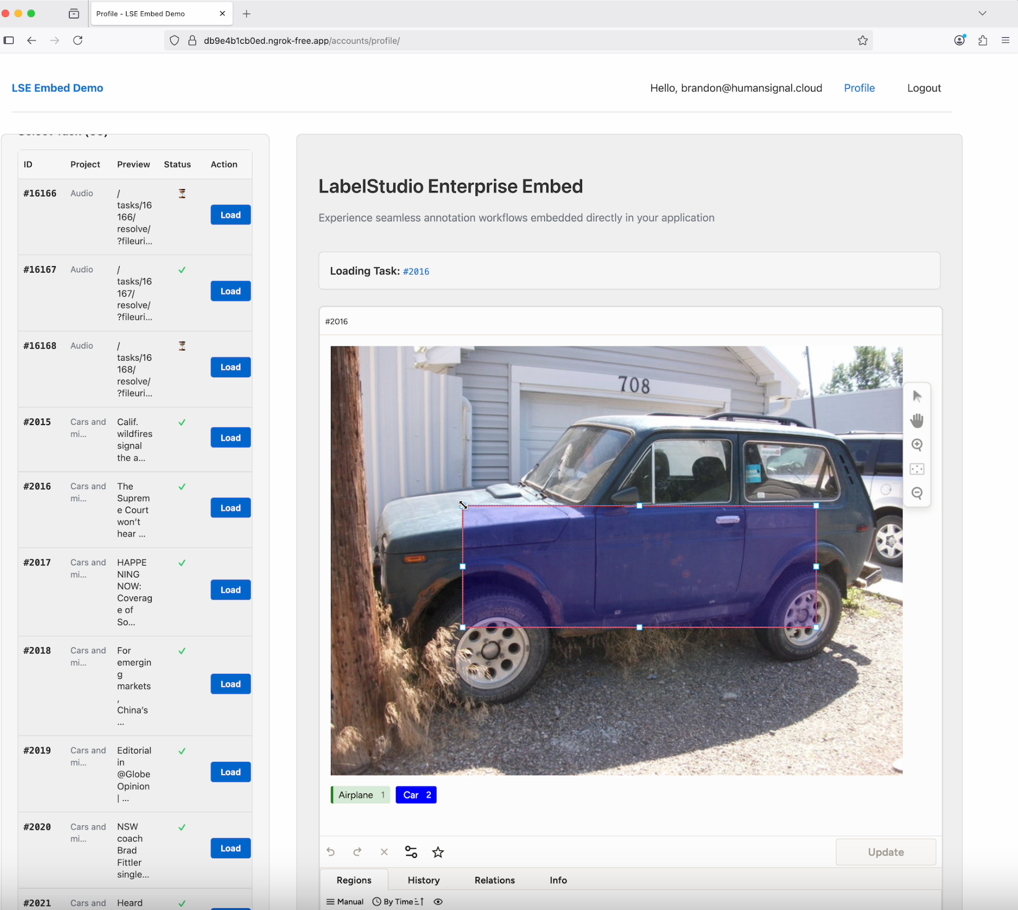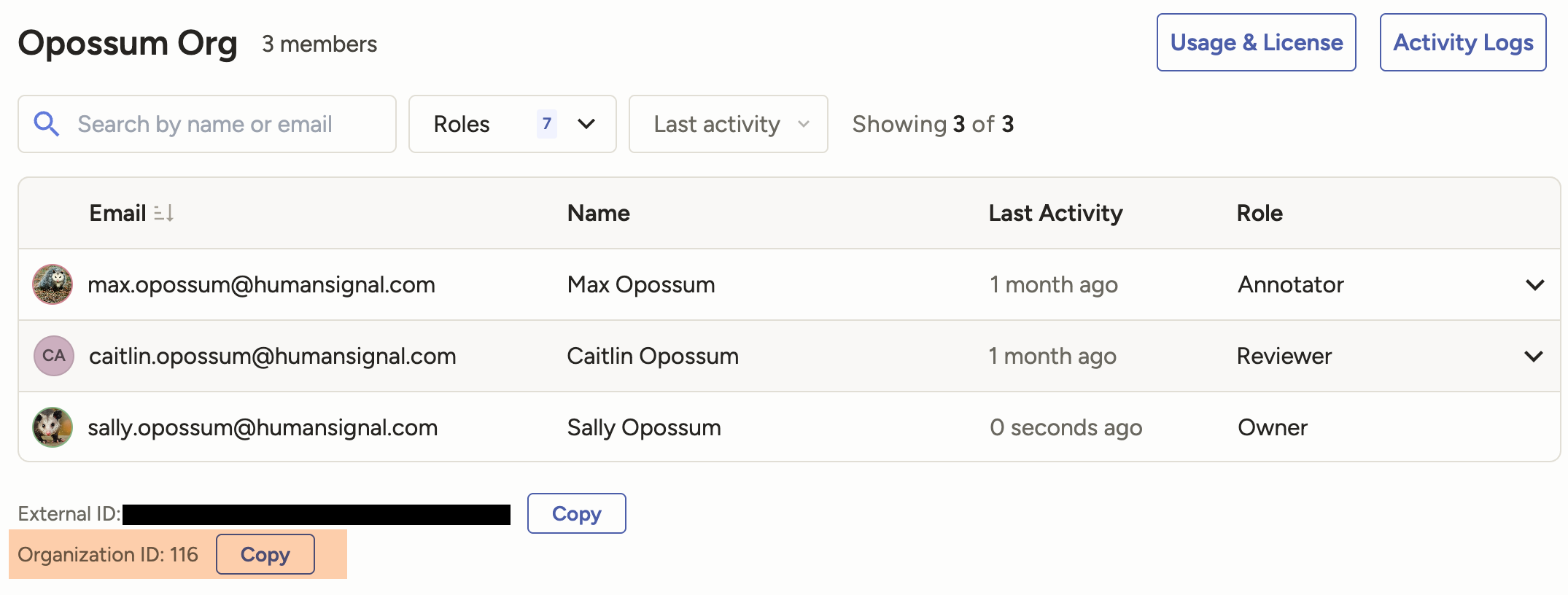Embed Label Studio - Beta 🧪
Label Studio Embeds allow you to seamlessly integrate annotation and review functionality into your own applications.
note
This feature is not available to all customers. Contact your HumanSignal account manager to enable.
Before you begin, ensure you have:
Label Studio:
- You must have the Owner role in Label Studio.
- From Organization > Settings > Access Token Settings, ensure that at least one option is enabled.
Your external application:
- Access to your server backend (to generate signed tokens).
- The URL where your embed will be hosted.

Authorization
At a high level, the embed process is a secure handshake between your app and Label Studio:
A user logs into your external app.
Your backend signs a JWT with their
user_emailandorganization_idusing your private key.Your frontend initializes the Label Studio embed with
id,url, andtoken.Label Studio validates the JWT and issues its own internal token.
sequenceDiagram
participant User
participant YourApp as Your App (Frontend & Backend)
participant LSE as Label Studio Enterprise
User->>YourApp: Logs in
YourApp->>YourApp: Backend signs JWT (user_email + organization_id)
YourApp->>User: Sends JWT to frontend
User->>LSE: Initializes Embed with (id, url, token)
LSE->>LSE: Verifies JWT with Public Key
LSE->>User: Issues Internal Token
User->>LSE: Annotates, Reviews, Uses EmbedGenerate a JWT on your server
You must begin by generating a JSON web token (JWT) that authenticates Label Studio.
You will also need to generate a base64-encoded public URL key, which you will add to Label Studio.
JWT claims required:
{
"user_email": "user@example.com",
"organization_id": "12345",
"iat": 1692445200, // (optional) issued-at timestamp
"exp": 1692452400 // (optional) expiration timestamp
}Notes:
- You can find your organization ID from the Organization page in Label Studio.
- The example below uses RS256 as a verification algorithm, but you can find a full list of supported algorithms from Organization > Usage & License > Embedding.
- The public key must be stored in Label Studio in base64-url encoded format.

Example: Node.js (jsonwebtoken)
const jwt = require("jsonwebtoken");
const fs = require("fs");
const privateKey = fs.readFileSync("./private.pem");
const token = jwt.sign(
{
user_email: "user@example.com",
organization_id: "12345",
},
privateKey,
{ algorithm: "RS256", expiresIn: "1h" }
);
console.log(token);Configure embedding in Label Studio
From Label Studio, go to Organization > Usage & License > Embedding and complete the following fields:
| Field | Description |
|---|---|
| Supported domains | List the domains of your external application where you will be adding an embedding. |
| Public Verification Key | This must be a base64-url encoded key. |
| Public Verification Algorithms | The algorithm you used when creating your key. |
| Embed SDK | Add this to your application to initialize the embedding. |
Configure an embedding page in your external application
At a minimum, you need to add the Embed SDK script to an HTML page in your application. For example:
<script src="https://app.humansignal.com/react-app/embed-sdk.js"></script>But to maximize the usability of your embedding, you can also include additional Label Studio elements. See our Frontend Reference.
Here is an example:
<html>
<body>
<!-- Outlet of Embed -->
<label-studio-embed id="embed-1"></label-studio-embed>
<!-- Inclusion of EmbedSDK script -->
<script src="https://app.humansignal.com/react-app/embed-sdk.js"></script>
<!-- Implementation Example -->
<script>
// Initialize the Label Studio Embed SDK
const sdk = LabelStudioEmbedSDK.create({
id: "embed-1", // targets the id of the `label-studio-embed` WebComponent that serves as the outlet of the embed
url: "https://app.humansignal.com", // url of the target LabelStudioEnterprise instance
token: "<signed-jwt-of-current-user>", // Signed JWT using private key of the paired public verify key configured in organization settings with following structure: {"user_email": "targetuser@email.com", "organization_id": <yourlseorg_id:int>}
mode: "label" // Loaded tasks and annotations for the user will be presented with a preconfigured interface for the purpose of labeling
});
// Listen for ready events (this fires once after all of the embed is loaded with a given task)
sdk.on('ready', () => {
console.log('LSE Embed - SDK ready for task');
});
// Listen for error events
sdk.on('error', (error) => {
console.error('LSE Embed - SDK error:', error);
});
// Listen for task load events
sdk.on('taskLoad', (task) => {
console.error('LSE Embed - Task load:', task);
});
// Listen for annotation select (switching/loading annotation) events
sdk.on('selectAnnotation', (annotation) => {
console.error('LSE Embed - Annotation select:', annotation);
});
// Listen for entity (region/label data) create events
sdk.on('entityCreate', (entity) => {
console.log('LSE Embed - Entity create:', entity);
});
// Listen for entity (region/label data) delete events
sdk.on('entityDelete', (entity) => {
console.log('LSE Embed - Entity delete:', entity);
});
// Listen for annotation submission events
sdk.on('submitAnnotation', (annotation) => {
console.log('LSE Embed - Annotation submitted:', annotation);
});
// Listen for annotation update events
sdk.on('updateAnnotation', (annotation) => {
console.log('LSE Embed - Annotation updated:', annotation);
});
// Set Options
// ex. Load a task by id 1 (This is LSE task id, user in LSE must have access to the task or 403 authorization errors will be thrown)
sdk.setOptions({ taskId: 1 }); // Loads the most recent annotation for that given user if available
// ex. Select an annotation of a task by id 2 (This is LSE annotation id, user in LSE must have access to the task or 403 authorization errors will be thrown)
sdk.setOptions({ taskId: 1, annotationId: 2 }); // Will select and load the annotation if found
// ex. Select a prediction of a task by id 3 (This is LSE prediction id, user in LSE must have access to the task or 403 authorization errors will be thrown)
sdk.setOptions({ taskId: 1, predictionId: 3 }); // Will select and load the prediction if found
// ex. Change colorScheme of embed instance
sdk.setOptions({ colorScheme: "dark" }); // "dark", "light" or "auto"
</script>
</body>
</html>Troubleshooting
Blank/white screen
- Domain not listed in Supported Domains within Label Studio.
- Misconfigured/missing public verification key
- Misconfigured/missing public verification algorithms
- Verification of the external JWT failed to verify one or more of the claims provided (invalid JWT).
- Active organization of the user was different than specified in the JWT claims.
- Your org has not enabled legacy API tokens or personal access tokens (need at least one).
- User with the provided
user_emaildoes not exist onLabelStudioEnterprise
HTTP errors in SDK
403 (permission errors)
- User is not a member of the Project
- Task was not assigned to a user, but attempted to load
- User did not have access to an annotation or prediction, but it attempted to load anyways
404
- Task was not found
Other non-HTTP errors that caused a logical problem in the system.